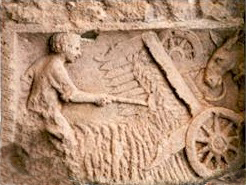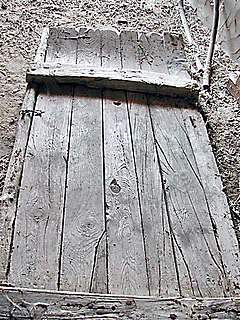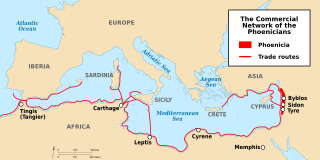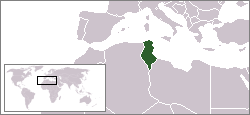
Carthage was the capital city of the ancient Carthaginian civilization, on the eastern side of the Lake of Tunis in what is now Tunisia. Carthage was the most important trading hub of the Ancient Mediterranean and one of the most affluent cities of the classical world.

Lucius Junius Moderatus Columella was a prominent writer on agriculture in the Roman empire.

Roman Agriculture describes the farming practices of ancient Rome, during a period of over 1000 years. From humble beginnings, the Roman Republic and empire expanded to rule much of Europe, northern Africa, and the Middle East and thus comprised many agricultural environments of which the Mediterranean climate of dry, hot summers and cool, rainy winters was the most common. Within the Mediterranean area, a triad of crops were most important: grains, olives, and grapes.
The Geoponica or Geoponika is a twenty-book collection of agricultural lore, compiled during the 10th century in Constantinople for the Byzantine emperor Constantine VII Porphyrogenitus. The Greek word Geoponica signifies "agricultural pursuits" in its widest sense. It is the only surviving Byzantine agricultural work.
Geoponici, or Scriptores rei rusticae, is a collective term for the Ancient Greece and Ancient Rome writers on husbandry and agriculture. In classical times it was regarded as a branch of economics.

Agriculture was the foundation of the Ancient Greek economy. Nearly 80% of the population was involved in this activity.
Mago was a Carthaginian writer, author of an agricultural manual in Punic which was a record of the farming knowledge of the Berbers from North Africa and the Phoenicians from Lebanon. The Punic text has been lost, but some fragments of Greek and Latin translations survive.
The jugerum or juger was a Roman unit of area, equivalent to a rectangle 240 Roman feet in length and 120 feet in width, i.e. 28,800 square Roman feet or about 1⁄4 hectare (0.623 acres).
Cassius Dionysius of Utica was an ancient Greek agricultural writer of the 2nd century BC. The Roman nomen, Cassius, combined with the Greek cognomen, Dionysius, make it likely that he was a slave, originally Greek-speaking, who was owned and afterwards freed by a Roman of the gens Cassia. Cassius Dionysius compiled a farming manual in Greek, now lost. Its title was Georgika ("Agriculture"); it was divided into twenty books, and was dedicated by its author to the Roman praetor Sextilius.
Diophanes of Nicaea or Diophanes the Bithynian was a Greek agricultural writer of the 1st century BC. He was a native of or associated with the city of Nicaea in Bithynia.
Passum was a raisin wine apparently developed in ancient Carthage and transmitted from there to Italy, where it was popular in the Roman Empire. The earliest surviving instruction constitutes the only known Carthaginian recipe. It is a fragment from the Punic farming manual by Mago in its Latin translation by Decimus Junius Silanus. It survives because it was summarised by Columella :

A threshing board, also known as threshing sledge, is an obsolete agricultural implement used to separate cereals from their straw; that is, to thresh. It is a thick board, made with a variety of slats, with a shape between rectangular and trapezoidal, with the frontal part somewhat narrower and curved upward and whose bottom is covered with lithic flakes or razor-like metal blades.

Ancient Rome played a pivotal role in the history of wine. The earliest influences on the viticulture of the Italian peninsula can be traced to ancient Greeks and the Etruscans. The rise of the Roman Empire saw both technological advances in and burgeoning awareness of winemaking, which spread to all parts of the empire. Rome's influence has had a profound effect on the histories of today's major winemaking regions in France, Germany, Italy, Portugal and Spain.
Agathocles was a Greek historian who wrote a history of Cyzicus in the Ionic dialect. He is called by Athenaeus both a Babylonian and a Cyzican. He may originally have come from Babylon, and have settled at Cyzicus. The first and third books are referred to by Athenaeus. The time at which Agathocles lived is unknown, and his work is now lost; but it seems to have been extensively read in antiquity, as it is referred to by Cicero, Pliny, and other ancient writers. Agathocles also spoke of the origin of Rome. The scholiast on Apollonius cites Memoirs (ὑπομνήματα) by an Agathocles, who is usually supposed to be the same as the above-mentioned one.

The Germani were an obscure pre-Roman ancient people of the Iberian Peninsula which settled around the 4th century BC in western Oretania, an ancient region corresponding to the south of Ciudad Real and the eastern tip of Badajoz provinces.

The culture of the ancient Phoenicians was one of the first to have had a significant effect on the history of wine. Phoenicia was a civilization centered in current day Lebanon. Between 1550 BC and 300 BC, the Phoenicians developed a maritime trading culture that expanded their influence from the Levant to North Africa, the Greek Isles, Sicily, and the Iberian Peninsula. Through contact and trade, they spread not only their alphabet but also their knowledge of viticulture and winemaking, including the propagation of several ancestral varieties of the Vitis vinifera species of wine grapes.

The Battle of Carteia, also known by the modern name Battle of the Guadalquivir, was a battle of the Second Punic War that took place in 206 BC between the forces of Carthage and the Roman Republic. The name "Battle of the Guadalquivir" is anachronistic, since the river's name "el Guadalquivir", from the Arabic al-wadi al-kabir, was not used until the Islamic conquest of Spain over nine hundred years after the battle. The Carthaginian forces were commanded by Hanno and the Romans by Gaius Lucius Marcius Septimus. The battle resulted in a Roman victory.

Tunisian wine has a long history dating back to the Antiquity like most Mediterranean countries with the Phoenicians and Carthage.

A chaplet is a headdress in the form of a wreath made of leaves, flowers or twigs woven into a ring. It is typically worn in festive occasions and on holy days. In ancient times it also served as a crown representing victory or authority.
Larus was a leader of Cantabrian mercenaries in the Carthaginian army during the Second Punic War, according to Silius Italicus's poem Punica.